Prednisone is a corticosteroid often prescribed for various health conditions in cats.
Cats can take prednisone, but you should only give it under strict veterinary guidance.
This medication can significantly help improve your cat’s quality of life when managing issues like autoimmune diseases or severe allergies, but it’s essential to know how it works and the potential risks involved.
Understanding when and how to use prednisone is vital for any cat owner.
While it can provide relief from distressing symptoms, the necessary dosage and any side effects must be carefully monitored to ensure your feline friend remains healthy and happy.
With the right approach, you can provide your cat with the care it needs without unnecessary complications.
Key Takeaways
- Prednisone can improve quality of life for cats with certain health issues.
- Strict veterinary supervision is essential when administering prednisone.
- Awareness of side effects is crucial for safely managing your cat’s treatment.
Understanding Prednisone and Its Purpose
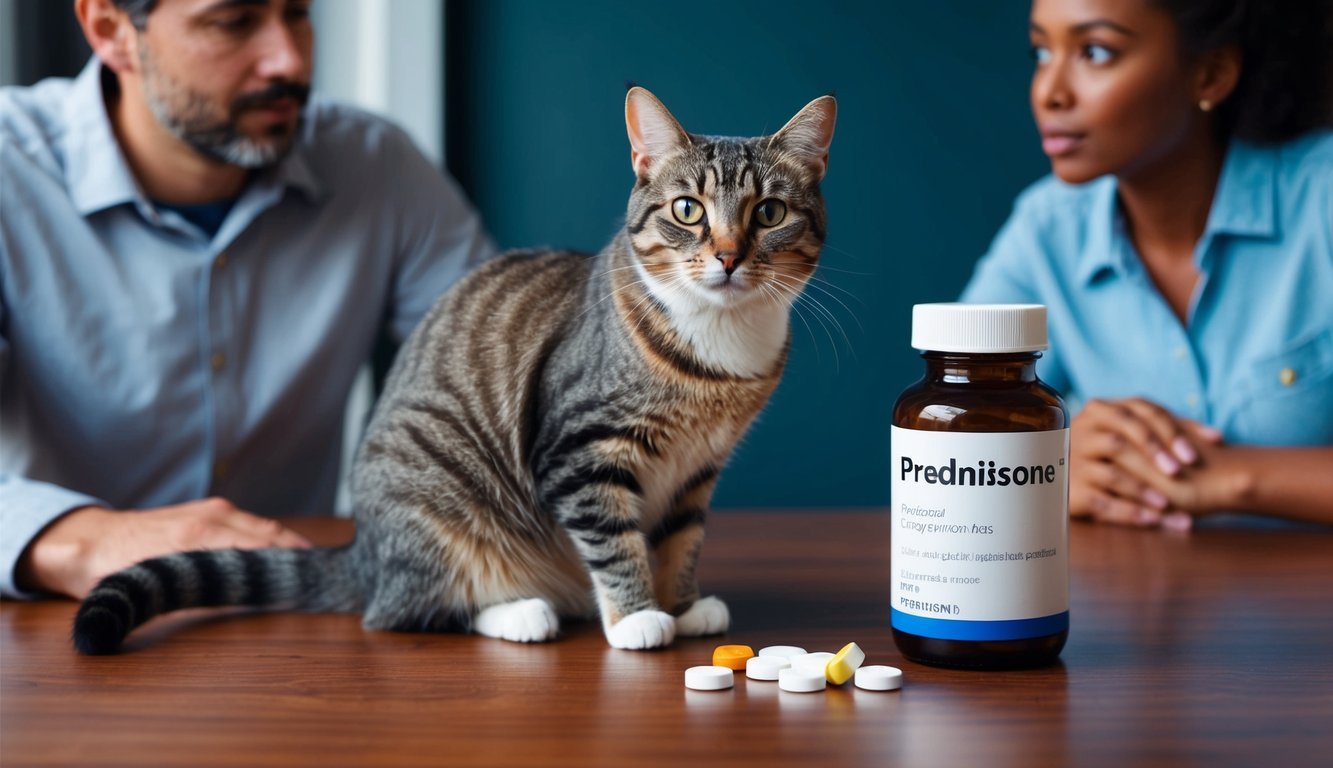
Prednisone is a corticosteroid with significant therapeutic uses in veterinary medicine, especially for cats.
Understanding its variations and how these medications function is crucial for managing your pet’s health.
Prednisone Vs. Prednisolone
Prednisone and prednisolone are often used interchangeably but are not identical.
Prednisone is a prodrug, meaning it converts to prednisolone in the liver.
- Prednisone: Generally prescribed when the cat’s liver function is normal, as it requires conversion for effectiveness.
- Prednisolone: Used directly, particularly in cases where liver health is a concern, as it bypasses the need for conversion.
Both drugs belong to the glucocorticoid class and have anti-inflammatory properties.
They reduce inflammation and suppress the immune response, making them effective in treating various conditions like allergies, autoimmune diseases, and certain cancers.
How Corticosteroids Work in Cats
Corticosteroids, like prednisone and prednisolone, mimic hormones produced by the adrenal glands.
They affect many bodily functions by modulating inflammation and immune responses.
These medications help manage symptoms such as:
- Allergies: Reducing the effects of allergens on your cat’s body.
- Autoimmune Disorders: Suppressing an overactive immune response that can harm tissues.
- Inflammation: Easing swelling and discomfort in conditions like arthritis.
By interacting with specific receptors, glucocorticoids alter the expression of genes that lead to inflammation.
This process can help your cat feel more comfortable and improve overall well-being.
Always consult your vet regarding dosage and possible side effects when using corticosteroids.
Indications for Prednisone in Cats
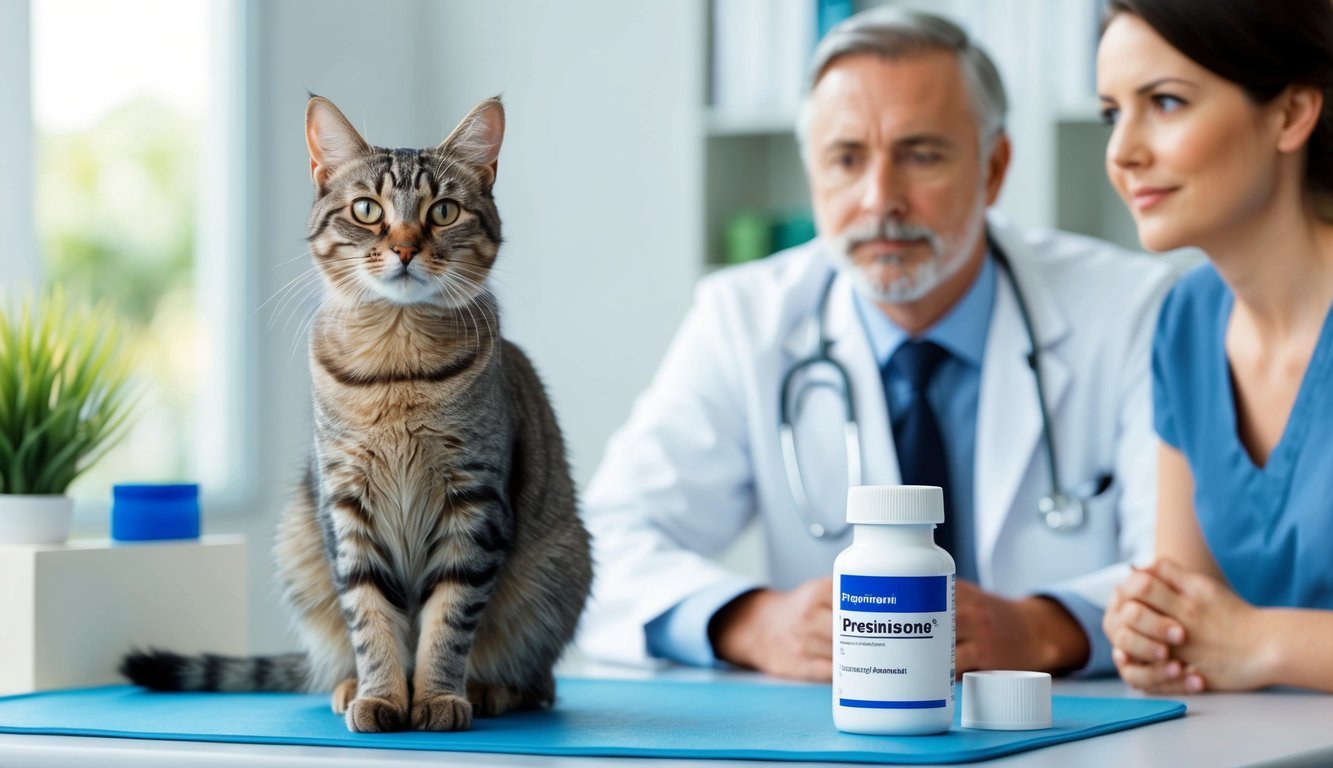
Prednisone is commonly prescribed for various conditions in cats, primarily targeting inflammation and immune responses.
It’s crucial to understand the specific health issues that may require this medication.
Allergic Reactions and Asthma
Cats can suffer from allergies just like humans.
These allergies may manifest as skin irritations, itching, or respiratory issues such as asthma.
Prednisone helps reduce inflammation associated with these symptoms.
For instance, a cat with allergic dermatitis may benefit significantly from this medication, alleviating itchiness and skin redness.
In cases of feline asthma, prednisone can decrease airway inflammation, making it easier for your cat to breathe.
The typical dosage for these conditions varies, so it’s vital to follow your veterinarian’s guidance closely.
Inflammatory Bowel Disease and Gastrointestinal Disorders
Inflammatory bowel disease (IBD) is a common issue in cats that can cause vomiting, diarrhea, and weight loss.
Prednisone is effective in managing the inflammation associated with IBD and can help restore normal gastrointestinal function.
By suppressing the immune response, prednisone reduces inflammation in the gastrointestinal tract, allowing your cat to absorb nutrients more effectively.
Many veterinarians may recommend a gradual dosage adjustment based on your cat’s response to the medication.
Monitoring your cat during treatment is essential to address any potential side effects promptly.
Dosage and Administration
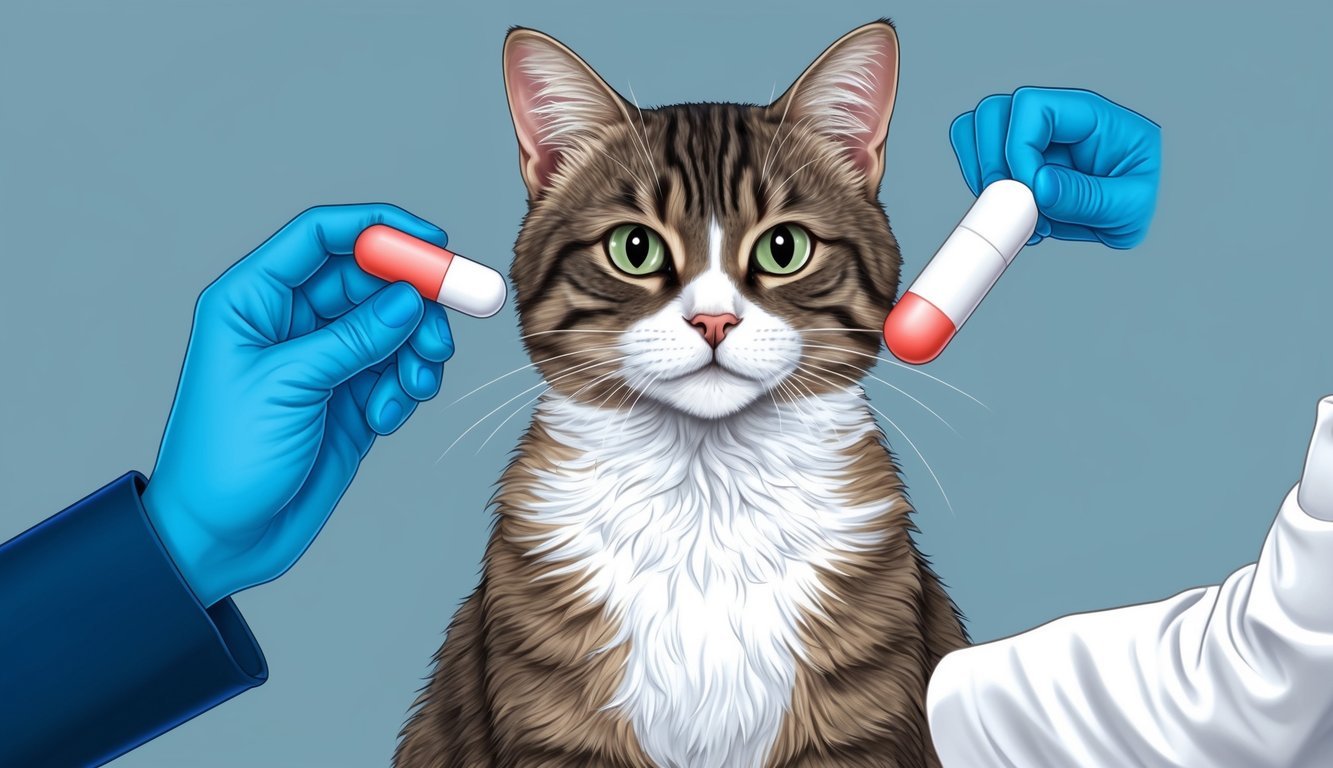
When considering prednisone for your cat, understanding the right dosage and administration methods is essential.
The appropriate dosage will vary based on your cat’s specific health needs and weight.
Different formulations of prednisone can also affect how you give the medication.
Proper Dosage Guidelines
The dosage of prednisone for cats typically ranges from 0.5 mg to 4 mg per kilogram of body weight per day.
It is often divided into two or three doses.
For example, if your cat weighs 10 pounds (approximately 4.5 kg), the dosage might be between 5 mg and 18 mg daily.
Your veterinarian will determine the best dosage for your cat based on factors like age, health condition, and response to treatment.
Always adhere to your vet’s recommendations rather than adjusting the dose on your own, as misuse can lead to serious side effects.
Prednisone Formulations
Prednisone comes in several formulations, including:
- Tablets: Commonly prescribed and easy to administer for most cats.
- Syrups and liquids: Suitable for cats that struggle with swallowing pills.
- Injections: Often used for faster consumption or when oral administration isn’t possible.
Each formulation has its method of administration.
For tablets, it’s helpful to hide them in food, while liquid forms can be given via a syringe or dropper.
Consult your vet for guidance on which form is best for your cat’s situation.
Regimens for Chronic Conditions
For chronic conditions, your cat may need a long-term regimen using prednisone.
In these cases, the dosage usually starts higher and is gradually tapered down.
This approach helps maintain effectiveness while minimizing potential side effects.
It’s crucial to monitor your cat closely during this process.
Frequent check-ins with your vet will provide guidance on adjusting the dosage as needed.
Chronic use increases the importance of regular assessments to prevent complications such as adrenal suppression, which can result from sudden discontinuation of the medication.
Potential Side Effects and Risks
When considering prednisone for your cat, it’s important to be aware of potential side effects and risks associated with its use.
This medication can bring significant relief for various conditions, but it may also introduce some unwanted challenges.
Common Side Effects
Prednisone can cause several common side effects in cats.
You might notice your cat experiencing increased thirst and urination, symptoms known as polydipsia and polyuria.
These effects occur because the medication alters fluid balance in your cat’s body.
An increased appetite, leading to weight gain, is also common.
Your cat may seem hungrier than usual, which can make monitoring their food intake crucial.
Gastrointestinal issues such as vomiting or diarrhea may arise, so it’s wise to keep an eye on their litter box behavior.
If you observe panting or unusual lethargy, these could also be signs of prednisone’s impact.
Keeping a close watch on your furry friend can help you catch any side effects early.
Long-Term Risks and Complications
Long-term use of prednisone poses risks that you should not overlook.
One major concern is the development of Cushing’s disease, a condition caused by excess cortisol in the body.
Symptoms may include a pot-bellied appearance, thinning skin, and recurrent infections.
Your cat may also face an increased risk of diabetes mellitus, especially if they develop a significant appetite increase coupled with weight gain.
Chronic use can weaken the immune system, making your cat more susceptible to infections.
Lastly, consider Addison’s disease, a condition that can occur upon withdrawal from long-term steroid use, leading to severe health complications.
Always consult with your veterinarian about the safe duration for prednisone administration.
Signs of Adverse Reactions
It’s essential to know the signs of adverse reactions when your cat is on prednisone.
If your cat shows sudden swelling, difficulty breathing, or skin reactions, this could mean they are experiencing an anaphylactic shock.
Immediate veterinary attention is crucial in such cases.
Watch for behavioral changes, like increased aggression or withdrawal from familiar activities, which might indicate discomfort.
Persistent vomiting or diarrhea that lasts longer than a day should prompt a vet visit, as these symptoms can lead to dehydration.
If you notice any concerning symptoms, getting your cat assessed can help manage their health effectively.
Monitoring and Safety Precautions
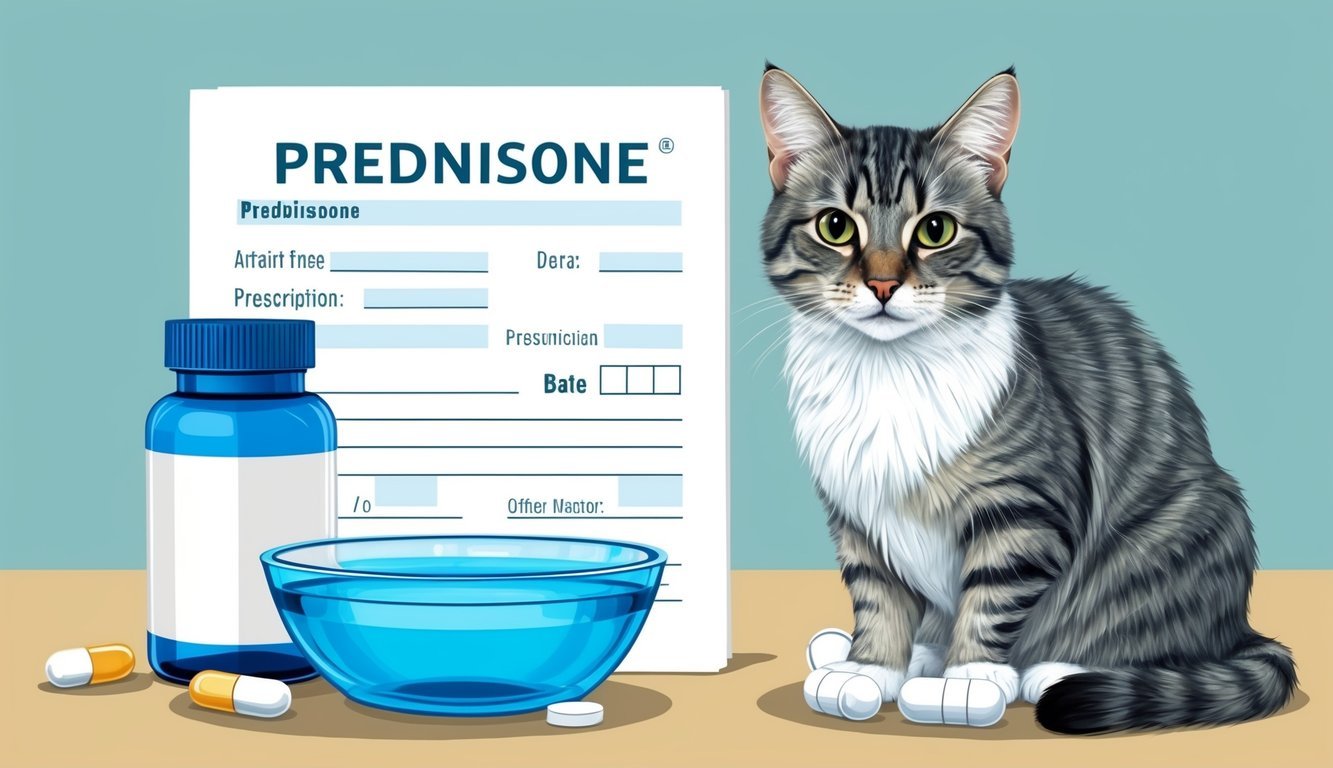
When your cat is on prednisone, regular monitoring and attention to safety are essential.
Vigilant observation helps mitigate risks such as infections and side effects while ensuring appropriate management of treatment.
Regular Veterinary Check-Ups
Regular veterinary check-ups are crucial when your cat is prescribed prednisone.
Routine visits allow your vet to assess the effectiveness of the medication and make dosage adjustments as needed.
During these appointments, your veterinarian may perform blood tests to monitor liver function and adrenal gland health.
Prednisone can impact these organs, especially with long-term use.
Keep track of any changes in your cat’s behavior, weight, or appetite to report.
The usual recommendation is for check-ups every 3 to 6 months, but your vet might suggest more frequent visits depending on your cat’s specific situation.
Always stay proactive in discussing any concerns that arise during your cat’s treatment.
Managing Long-Term Therapy
If your cat needs long-term prednisone therapy, consider implementing management strategies to minimize potential side effects.
Monitor your cat for signs of weight gain, increased thirst, or changes in urine output, which can indicate possible complications.
Make dietary adjustments by offering a balanced diet with reduced calories and healthy treats to counter weight gain.
Encouraging hydration is also vital; ensure your cat has constant access to fresh water.
Keeping your living environment stress-free can help, as stress may exacerbate conditions requiring prednisone.
Communication with your veterinarian about any observed changes is necessary for adjusting treatment plans.
When to Seek Immediate Care
You should be aware of several warning signs that necessitate immediate veterinary care during prednisone treatment.
If your cat shows symptoms such as difficulty breathing, severe lethargy, or a sudden change in behavior, seek help right away.
Other concerning signs include persistent vomiting, diarrhea, or signs of infection, such as fever or unusual swelling.
Prednisone can suppress your cat’s immune system, making infections more likely.
Be vigilant about any sudden changes, especially if your cat is already on long-term prednisone.
Quick action can ensure prompt evaluation and treatment, which can be vital for your cat’s well-being.
Prednisone Alternatives and Supplementary Therapies
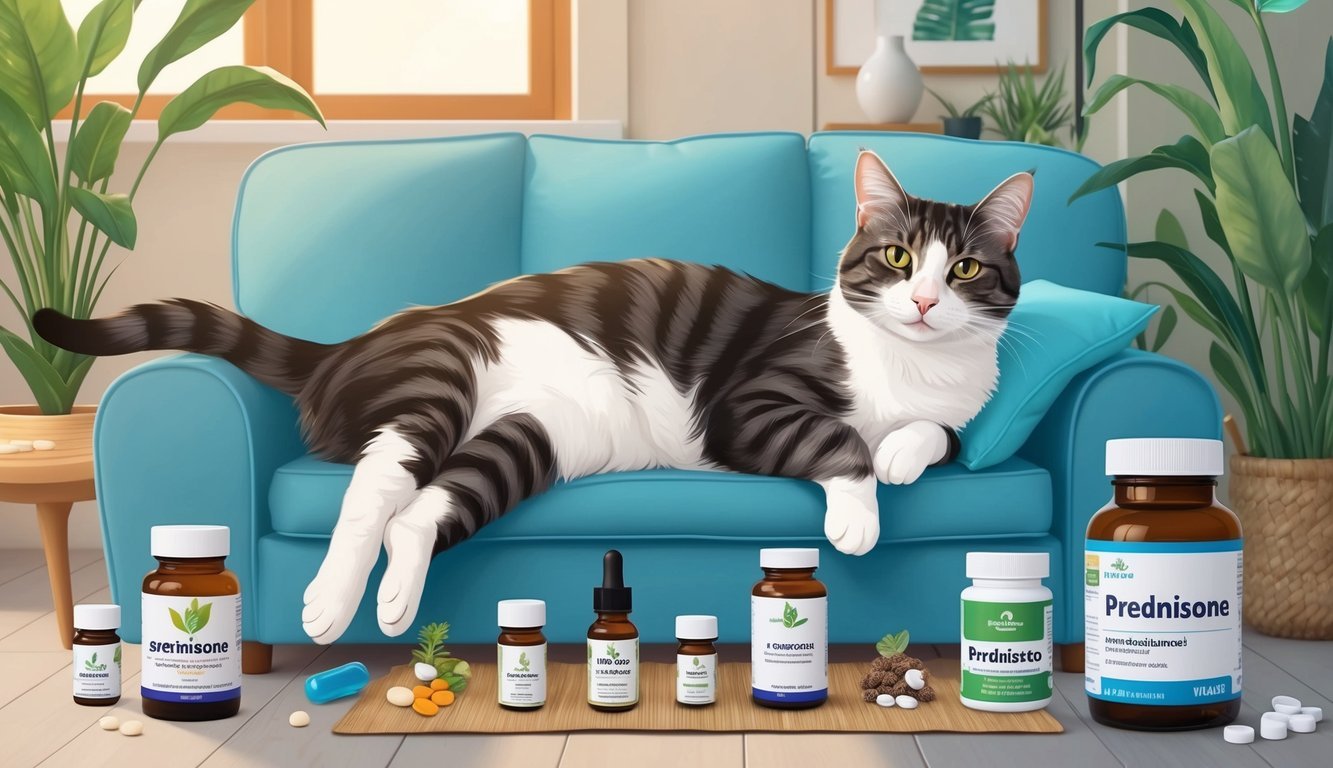
When considering alternatives to prednisone, you have several options that can help manage your cat’s inflammation and overall health.
From different medications to alternative therapies, there are choices available to support your furry friend.
Alternative Medications
If you’re looking for alternatives to prednisone, several synthetic and natural options may suit your cat’s needs.
-
Budesonide: This steroid is less likely to cause side effects and can effectively manage inflammatory conditions.
-
Apoquel: Primarily for allergies, it targets itchiness without the broader effects of steroids.
-
Cyclosporine: This immunosuppressant helps with autoimmune diseases and is often used for chronic conditions.
Make sure to consult your veterinarian about these options.
They can assess your cat’s specific condition and recommend suitable alternatives based on their health.
Dietary Changes and Supplements
Adjusting your cat’s diet can significantly impact their inflammation levels and overall health.
Consider incorporating:
-
Omega-3 Fatty Acids: Found in fish oil, these can help reduce inflammation and support joint health.
-
Antioxidant-rich Foods: Blueberries, spinach, and sweet potatoes contain properties that combat inflammation.
-
Glucosamine and Chondroitin: These supplements promote joint health and may be beneficial if your cat has arthritis or similar conditions.
Discuss any dietary changes with your vet to ensure they align with your cat’s medical needs.
A balanced diet can aid in managing your cat’s inflammation while supporting their immune function.
Holistic and Supportive Treatments
Holistic therapies can provide additional support alongside medication.
Some options you might explore include:
-
Acupuncture: This technique can alleviate pain and inflammation, fostering better overall health.
-
Homeopathy: Remedies such as urtica and sulfur may help treat specific conditions.
-
Physical Therapy: Tailored exercises can enhance mobility for older cats or those suffering from arthritis.
Before starting any new treatments, consult your vet.
Every cat is unique, and a personalized approach ensures the best outcomes for their health.
Conclusion: Balancing Treatment Benefits and Risks
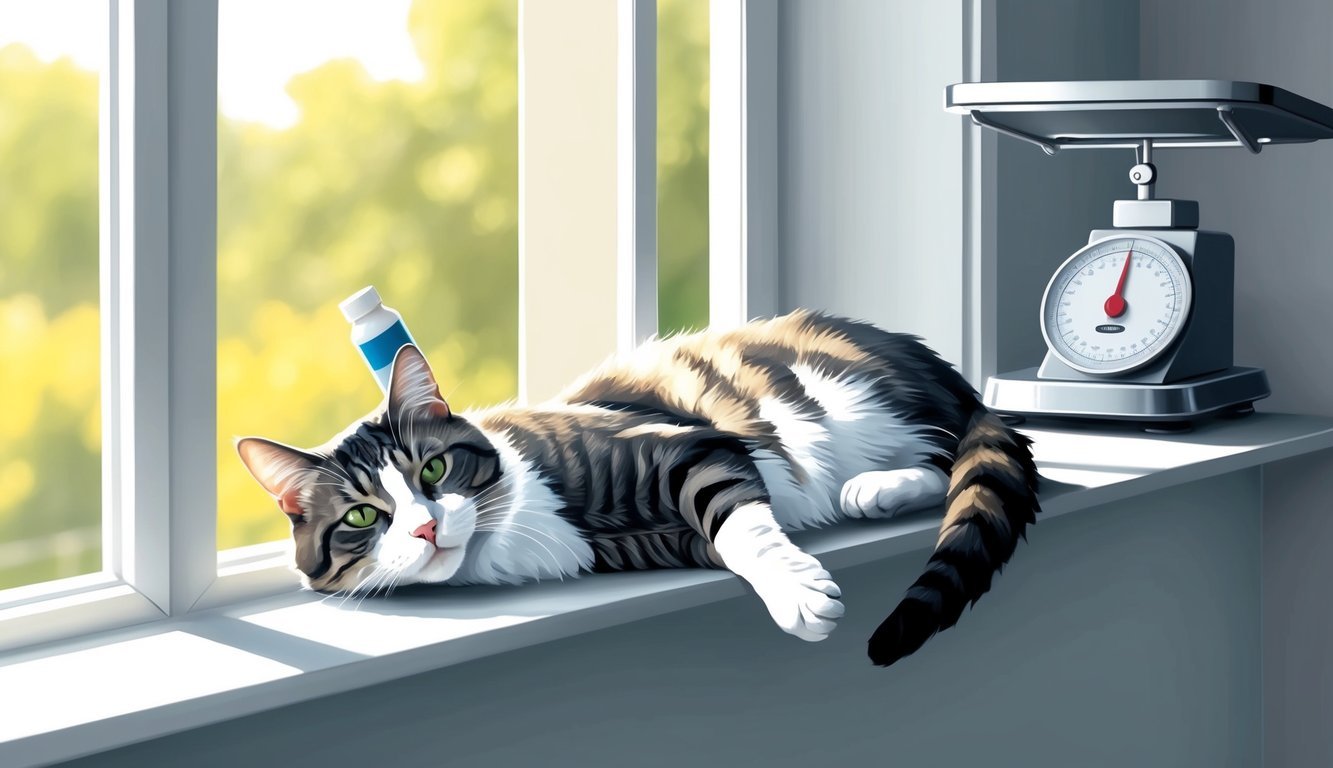
When considering prednisone for your cat, it’s crucial to weigh the benefits against the potential risks.
Benefits:
- Quality of Life: Prednisone can significantly improve your cat’s comfort if they suffer from conditions like allergies or inflammatory diseases.
- Effective Treatment: It may help control inflammation and immune responses, making it valuable in serious health issues.
Risks:
- Side Effects: Long-term use can lead to increased thirst, urination, and potential weight gain.
- Health Complications: Some cats may develop diabetes, and flare-ups of infections can occur.
Understanding how prednisone can affect your cat is essential.
The goal is to enhance their quality of life while minimizing adverse effects.
Regular veterinary check-ups are vital to monitor any changes and adjust treatment as needed.
If you’re considering prednisone, always consult your veterinarian.
They can help you navigate the benefits and risks specific to your cat’s health needs.
Frequently Asked Questions
When considering prednisone for your cat, you might have specific questions about dosage, risks, and its effects compared to other medications.
Here are some answers to common concerns regarding the use of prednisone in felines.
What is the appropriate dosage of prednisone for a cat?
The typical dosage for cats is about 1 mg per pound of body weight.
In certain cases, such as treating autoimmune conditions, the dose can increase to 3 mg per pound.
Always consult your veterinarian for the exact amount needed for your cat’s specific condition.
Are there any risks associated with giving prednisone to cats?
Yes, there are risks.
Long-term use or high doses can lead to serious side effects like diabetes, weight gain, and immune system suppression.
Being aware of potential changes in your cat’s behavior or health is crucial during treatment.
Is there a difference between prednisone and prednisolone for feline use?
Prednisolone is often preferred for cats because they convert prednisone to prednisolone less efficiently.
In many cases, veterinarians will prescribe prednisolone directly to avoid any conversion issues, ensuring your cat receives the intended treatment.
Can I administer prednisone prescribed for dogs to my cat?
No, you should not give your cat prednisone prescribed for dogs.
Dosages and formulations can vary significantly between species.
Always use medication specifically prescribed for your cat to avoid harming their health.
How does prednisone affect a cat’s breathing problems?
Prednisone can help reduce inflammation in the airways, making it easier for your cat to breathe.
This medication is commonly used in cases of asthma or allergic reactions, but monitoring is essential to manage any potential side effects.
What should I do if my cat has an adverse reaction to prednisone?
If you notice unusual behavior, lethargy, increased thirst, or gastrointestinal issues, contact your veterinarian immediately.
Report any adverse reactions, as they may need to adjust the treatment or provide additional care.

